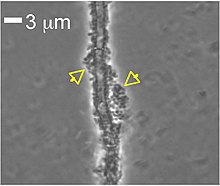Lysobacter
| Lysobacter | |
|---|---|
 |
|
| Attachment of Lysobacter enzymogenes strain C3 to fungal hyphae of Magnaporthe oryzae (also known as rice blast and gray leaf spot of turfgarss) | |
| Scientific classification | |
| Domain: | Bacteria |
| Phylum: | Proteobacteria |
| Class: | Gammaproteobacteria |
| Order: | Xanthomonadales |
| Family: | Xanthomonadaceae |
| Genus: | Lysobacter |
The genus Lysobacter belongs to the family Xanthomonadaceae within the Gammaproteobacteria and includes 13 named species: Lysobacter enzymogenes, L. antibioticus, L. gummosus, L. brunescens, L. defluvii, L. niabensis, L. niastensis, L. daejeonensis, L. yangpyeongensis, L. koreensis, L. concretionis, L. spongiicola, and L. capsici.Lysobacter spp. were originally grouped with myxobacteria because they shared the distinctive trait of gliding motility, but they uniquely display a number of traits that distinguish them from other taxonomically and ecologically related microbes including high genomic G+C content (typically ranging between 65 and 72%) and the lack of flagella. The feature of gliding motility alone has piqued the interest of many, since the role of gliding bacteria in soil ecology is poorly understood. In addition, while a number of different mechanisms have been proposed for gliding motility among a wide range of bacterial species, the genetic mechanism in Lysobacter remains unknown. Members of the Lysobacter group have gained broad interest for production of extracellular enzymes. The group is also regarded as a rich source for production of novel antibiotics, such as β-lactams containing substituted side chains, macrocyclic lactams and macrocyclic peptide or depsipeptide antibiotics like the katanosins.
Lysobacter spp. have been described as ubiquitous inhabitants of soil and water. Their presence has been largely ignored, since members often are minor components in sample screenings when using conventional isolation procedures. However, because of improved molecular methods of identification and better descriptions for the genus, their agricultural relevance is becoming increasingly evident, especially as members of ecologically significant microbial communities associated with soil and plants. Recent evidence suggests Lysobacter spp. may occupy a wide range of ecological niches beyond those associated with plants, including a broad range of 'extreme' environments. For example, 16S rDNA phylogenetic analyses show Lysobacter clades that include sequences obtained from hydrothermal vents, isolates from Mt. Pinatubo mud flows and upflow anaerobic blanket sludge reactors, and an iron-oxidizing, microaerophilic lithotroph.
...
Wikipedia
